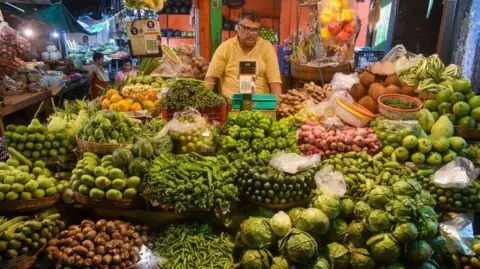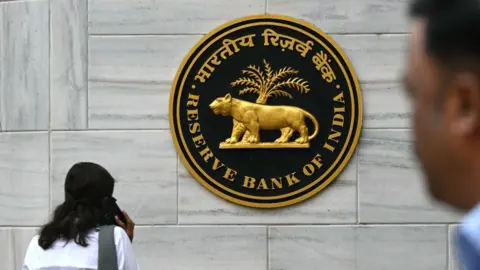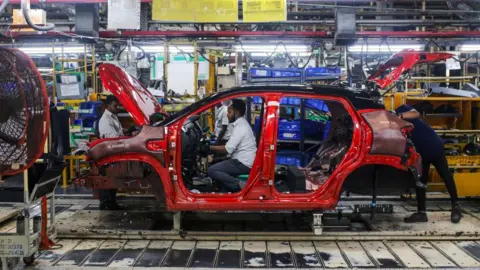Is the world’s fastest-growing major economy losing momentum?

 Getty Images
Getty ImagesIs the world’s fastest-growing major economy losing momentum?
The latest GDP numbers paint a sobering picture. Between July and September, India’s economy shrank to a seven-quarter low of 5.4%, well below the Reserve Bank of India’s (RBI) forecast of 7%.
Although still strong compared to developed countries, this figure shows a decline.
Economists attribute this to several factors. Consumer demand has weakened, private investment has slowed and government spending – a key driver in recent years – has been withdrawn. India’s exports have been struggling for a long time, and their share stands at 2% in 2023.
Fast moving consumer goods (FMCG) companies report hot sellingwhile wage bills for publicly traded companies, representative of urban wages, shrink last quarter. Even the earlier bullish RBI has revised its growth forecast to 6.6% for the financial year 2024-2025.
“All hell seems to have broken loose after the latest GDP numbers,” said economist Rajeshwari Sengupta. “But this has been building for a long time. There is a clear slowdown and a huge demand problem.”
Finance Minister Nirmala Sitharaman paints a rosy picture. He said last week there was a decline “not the plan” but the result of reduced government spending during the election-focused quarter. He expected third-quarter growth to offset the recent slowdown. India will likely remain a fast-growing major economy despite challenges such as stagnant wages affecting domestic consumption, reduced global demand and climate disruptions in agriculture, Sitharaman said.
 Getty Images
Getty ImagesOthers – including the elder minister to the federal government, economists again who was a member of RBI’s monetary policy group – they say the central bank’s focus on reducing inflation has led to very restrictive interest rates, which may hamper growth.
Higher rates make borrowing more expensive for businesses and consumers, and are likely to reduce investment and dampen consumption, both of which are important drivers of economic growth. The RBI has kept interest rates unchanged for almost two years, mainly due to rising inflation.
Inflation in India rose to 6.2% in October, breaking the ceiling targeted by the central bank (4%) and reaching a 14-month high, according to official data. It was largely driven by food prices, which make up part of the consumer basket price – vegetable prices, for example, rose more than 40% in October. There are also growing signs that rising food prices are now impacting other daily costs, or core inflation.
But higher interest rates alone may not fully explain declining growth. “Cutting rates will not stimulate growth unless consumption demand is strong. Investors borrow and invest only when there is demand, and that is not the case now,” said Himanshu (he uses only one name), a development economist at Delhi’s Jawaharlal Nehru University.
However, the outgoing RBI governor, Shaktikanta Das, believes that “India’s growth story remains intact”, adding “the balance between inflation and growth is fine”.
Economists point out that despite record high credit sales and increase in unsecured loans – which shows people who borrow to get the use of funds even at high rates – urban demand is decreasing. Rural demand is a bright spot, benefiting from a good monsoon and high food prices.
 AFP
AFPMs Sengupta, an associate professor at the Indira Gandhi Institute of Development Research in Mumbai, told the BBC that the ongoing crisis was evidence that India’s economy was operating at “double speed”, driven by the diversity of its sports. “the old economy and the new economy”.
The old economy that includes a large informal sector, including small and medium industries, agriculture and the general corporate sector, is still waiting for long overdue reforms.
In contrast, the new economy, defined by the growth of services exported outside of Covid, experienced strong growth in 2022-23. Outsourcing 2.0 has been a key driver, with India emerging as the world’s largest hub of global talent centers (GCCs), performing high quality offshore services.
In accordance with Deloitteconsulting firm, more than 50% of the world’s GCCs are now based in India. These centers focus on R&D, engineering design and consulting services, generating revenues of $46bn (£36bn) and employing up to 2 million highly skilled workers.
“This influx of GCCs stimulated consumption in cities by supporting the demand for luxury goods, real estate and SUVs. 2-2.5 years after the pandemic, this caused an increase in urban spending. As GCCs became more established and consumption patterns changed, the decline in urban spending it went up. it’s getting dark,” said Ms. Sengupta.
So the old economy seems to lack a catalyst for growth while the new economy is slow. Private investment is important, but without strong demand for consumption, firms will not invest. Without investment to create jobs and increase incomes, consumption demand will not recover. “It’s a vicious cycle,” said Ms. Sengupta.
There are other confusing symptoms as well. India’s general taxes rose from 5% in 2013-14 to 17% now, it is more than Asian peers who trade with the US. In a world of global value chains, where exporters rely on imports from many countries, high tariffs make goods more expensive for companies to trade, making it difficult for them to compete in global markets.
 Getty Images
Getty ImagesThen there is what economist Arvind Subramanian calls “a new twist in the story”.
Even as calls grow to lower interest rates and increase the deficit, the central bank is propping up the falling rupee by selling dollars, which strengthens the economy. Since October, the RBI spent $50bn from its forex holdings to hedge the rupee.
Buyers must pay in rupees to buy dollars, which reduces the currency in the market. Keeping the rupee strong through intervention reduces competition by making Indian goods more expensive in world markets, leading to lower demand for exports.
“Why is the central bank fixing the rupee? The policy is bad for the economy and exports. They may be doing it for optics. They don’t want to show that the Indian currency is weak,” said Mr Subramanian, a former economic adviser. in government, he told the BBC.
Critics warn that the “narrative” of India as a fast-growing economy is derailing important reforms to boost investment, exports and job creation. “We are still a poor country. Our GDP per capita is less than $3,000, while the US is $86,000. If you say we are growing faster than them, it makes no sense at all,” said Ms. Sengupta.
In other words, India needs a very high and sustained growth rate to generate more jobs and increase income.
Increasing growth and consumption will not be easy in the short term. Due to the lack of private investment, Himanshu suggests raising wages through government-run employment programs to increase income and stimulate consumption. Others like Ms. Sengupta are advocating lowering tariffs and attracting investors from China to countries like Vietnam.
The government is still standing on this The story of India: banks are strong, forex reserves are strong, currencies are stable and extreme poverty is down. Senior economic adviser V Anantha Nageswaran says the latest GDP figure should not be over-interpreted. “We should not throw the baby out with the bathwater, as the issue of growth has stopped,” he said in a recent statement. meeting.
Obviously the pace of growth could do with some lifting. That is why doubts persist. “No nation is ambitious for so long without taking it [adequate] steps to achieve that ambition,” said Ms Sengupta. “Right now, the headlines are about India’s age and decade – I’m waiting for that to happen.”
Source link





